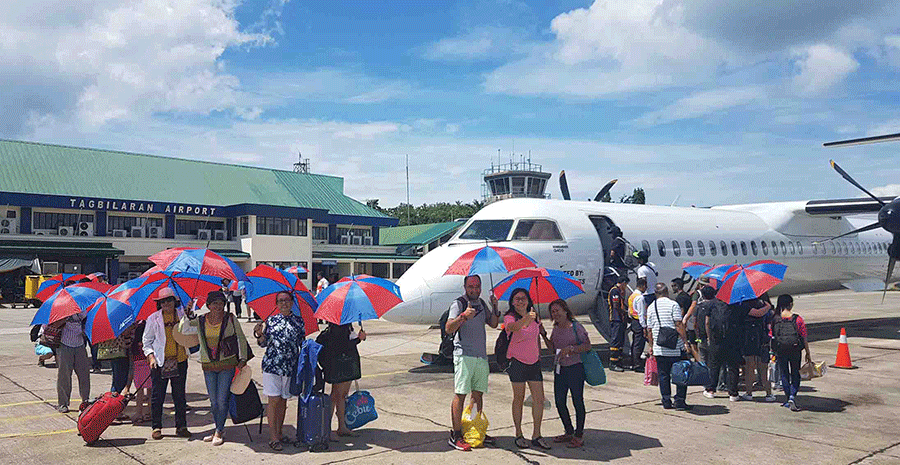Transformation from world-class to five-star airline characterized year 2017 for Philippine Airlines. The flag carrier shifted to high gear on initiatives to raise its rating by airline/airport rating company Skytrax to four stars in 2018, and eventually to five stars by 2020.
The goal is not a quick fix but a multi-year top-to-bottom re-invention of the airline. Singular focus is the passenger – an unceasing effort to extend total passenger care at every customer touch-point, while managing expectations every step of the journey.
PAL maintained its three-pronged strategy of fleet upgrades, route expansion and service innovation to achieve the goal.
New planes, new routes
Seven airplanes were delivered in 2017 – five Bombardier Q400 turboprops for inter-island flights and two Boeing 777-300ERs for long-haul routes.

On June 13, the first of eight reconfigured, tri-class Airbus A330s was unveiled, featuring one of the most luxurious cabins in the sky. This A330 first flew to Honolulu, followed by Sydney, Melbourne, Tokyo Haneda and other routes. From July to November, five dual-class, 86-seater Q400 were delivered. Its first commercial flight was Cebu-Caticlan in August.
Meanwhile, on December 15, a PAL 777 made the first trans-polar flight for a Philippine carrier – a 16.5-hour, non-stop Toronto-Manila flight – preceded by the upgrade of several routes from one-stop to non-stop in 2017: Manila-Doha, Manila-Auckland, Manila-Kuwait and Manila-Jeddah.
PAL’s complete fleet of ten 777s now fly to North America and London.
Additional airplanes enabled PAL to open new routes out of Cebu, Davao and Clark. On January 2, PAL operated its first international flight to Clark with the arrival of an A321 from Seoul. Other new routes include Seoul-Tagbilaran, Chengdu-Kalibo, Chengdu-Cebu, Manila-Kuala Lumpur, Cebu-Beijing and Cebu-Bangkok.
From having no Clark service in 2016, PAL vaulted to become the largest airline operator at Clark airport by the close of 2017, with flights from Clark to Bacolod, Basco, Busuanga, Calbayog, Catarman, Cagayan de Oro, Caticlan, Cebu, Davao, Masbate, Puerto Princesa, Tagbilaran, Virac and Seoul.
From Davao, PAL opened three new routes (Davao to Tagbilaran, Cagayan de Oro and Zamboanga) using the new Q400s.
Ten domestic routes were opened from Cebu – Siargao and Camiguin (new PAL destinations) as well as to Cagayan de Oro, Caticlan, Legazpi, Ozamiz, Puerto Princesa, Surigao, Tacloban and Tagbilaran.
Product innovations
PAL introduced a new Premium Economy product on its A330s (and soon A350s), offering all-new seats and amenities in a private cabin. A key service innovation is inflight connectivity – ensuring more passengers stay connected while flying, through wi-fi or mobile phone connection.

PAL also introduced new inflight menus, including signature Filipino dishes. The SwingAround Tour Packages were resumed, offering affordable travel packages.
In February, PAL introduced the first-ever nationwide crowd-sourced inflight safety video featuring nine of the best Philippine tourist destinations. PAL likewise enhanced its website and improved an array of check-in, transit, transfer and boarding procedures.
In 2017, the flag carrier proposed to build a NAIA Terminal 2 Annex that can accommodate up to 17 million passengers annually, with parking for up to 15 aircraft.
Different companies took notice of PAL’s transformation. Awards were given including 4th Best Airline Worldwide for Best Cabin Service, 6th Most Improved Airline, 2017 Subic Eco-Tourism Festival Award and Best Asia-Pacific Treasury Team.
Corporate Social Responsibility Projects
The PAL Foundation continued extending travel assistance to airlift relief goods to disaster-stricken areas. More than 15 tons of donations were flown to Cagayan de Oro for displaced Marawi residents, while seven local children flew to Manila to be resettled at an orphanage in Cavite. PAL Chairman Dr. Lucio C. Tan donated P2 million cash intended for soldiers who fought in Marawi.

Habitat for Humanity was given 750,000 miles that were converted to tickets to support its housing advocacy for indigent communities. A total of 149 indigent-patients (and their escorts) flew PAL to get emergency medical assistance. Recently, more than 13 tons of donations were airlifted to Davao for victims of typhoon Vinta in North Cotabato and Lanao del Norte.
Filipino athletes – from tennis and table tennis players to figure skaters – competed abroad flying PAL to represent the country under the PAL Foundation’s flagship program #RPRSNT Pinoy.
In September, 132 Filipinos were repatriated on a special PAL flight from Puerto Rico just before Hurricane Maria devastated the Caribbean island.
PAL employees actively participated in ecological projects such as the International Coastal Clean-up and tree-planting in a farm in Carranglan, Nueva Ecija.
Looking Forward to 2018
PAL looks forward to opportunities in 2018, when it introduces new Airbus A321 NEOs (February) and A350s (June) that will allow PAL to mount non-stop flights to Brisbane, India and the US East Coast (via the polar route).
The flag carrier will continue promoting its network through campaigns anchored on the “Heart of the Filipino” theme – e.g., Fly the Way You Deserve, More Heart, Experience the Heart of the Filipino, Stories from the Heart and Hugot Lines – and developing its “Buong Pusong Alaga” service philosophy.
The whole PAL organization is primed and ready to deliver a major boost in service that “comes only from the Heart of the Filipino” in a serious bid to become a five-star airline.


